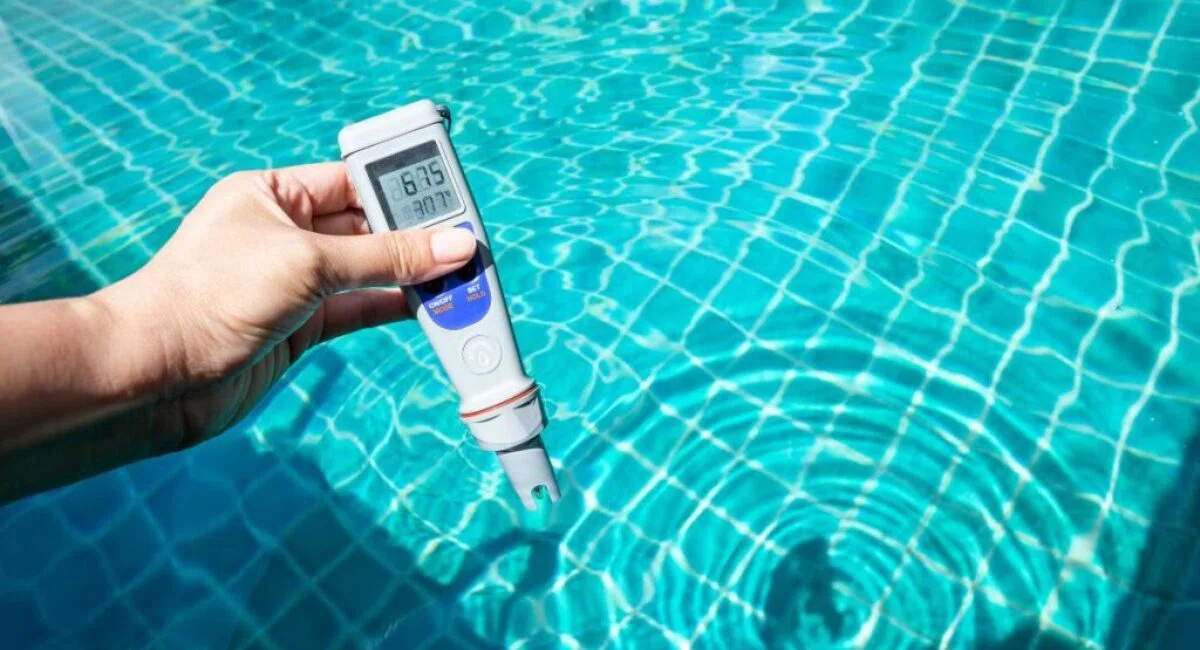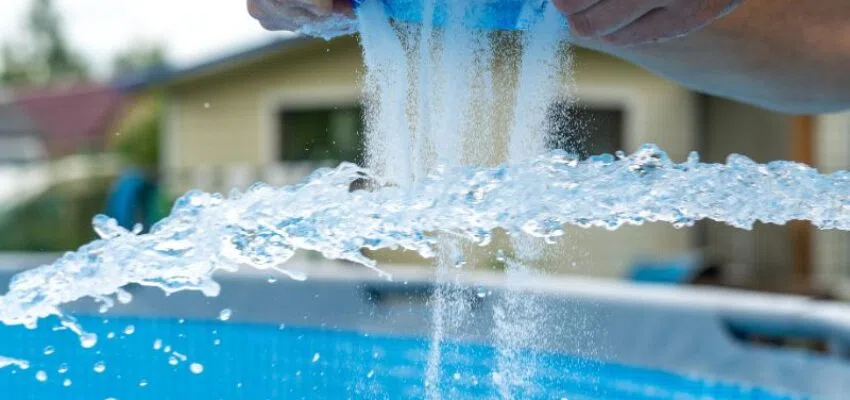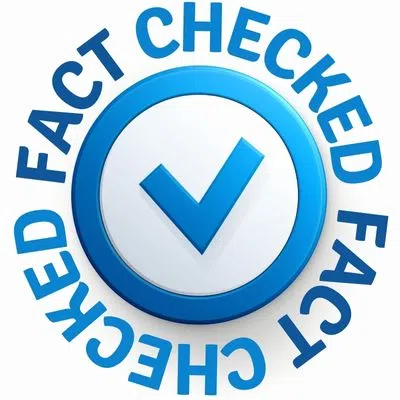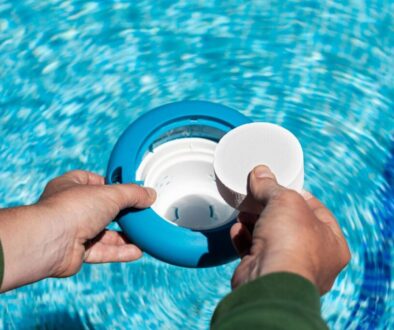How Much Salt to Add to Your Pool: A Guide to Achieving the Optimal Balance

Published June 3, 2023
Proper pool salt is essential for a well-balanced and enjoyable swimming experience. Whether you’re adding or adjusting the salt concentration, understanding the ideal pool salt level and how to calculate the right amount of salt is crucial.
In this guide, we’ll look into the intricacies of pool salt, the importance of saltwater pool chemistry, and provide a pool salt calculator to answer how much salt to add to a new pool startup.
Why Does Salt Matter?
Salt is vital in pool maintenance, impacting the water quality and overall swimming experience.
A properly salted pool can offer numerous benefits, including softer-feeling water, reduced eye and skin irritation, and enhanced buoyancy. It also acts as a natural sanitizer, reducing the need for traditional chlorine chemicals.
However, adding too little or too much salt can lead to problems, so striking the right balance is essential.
Understanding Pool Salt and Salt Water Pool Chemistry
Pool salt, also known as salt for pools, is a specialized type of salt used in saltwater pools. It contains fewer impurities than table salt or rock salt, making it ideal for maintaining water chemistry.
When added to a pool, the salt undergoes electrolysis in the saltwater chlorinator, producing chlorine gas that sanitizes the water. This process eliminates the need for traditional chlorine chemicals, resulting in a more gentle and pleasant swimming experience.
Determining the Ideal Salt Level
The ideal salt level for your pool depends on various factors, including your type of saltwater system and personal preference. Salt levels in saltwater pools typically range between 2,500 to 4,000 parts per million (ppm).[1]
To determine the precise salt level for your pool, it’s recommended to consult your pool manufacturer’s guidelines or seek professional advice. This ensures that you achieve the perfect balance for optimal performance.
Calculating the Right Amount of Salt for Pool Startup
Determining how much salt to add is crucial when starting a new pool. Using a pool salt calculator can simplify this process. These online tools consider factors such as pool size and desired salt level to provide accurate calculations.
Simply input the required information, and the calculator will determine the number of bags of salt needed for pool startup. Following the manufacturer’s guidelines and recommendations specific to your pool system is essential.
Step-by-Step Guide: How to Add Salt to Your Pool
Adding salt to your pool is a straightforward process that requires careful measurement and distribution. Follow these step-by-step instructions to ensure you add salt correctly and maintain the optimal salt level in your pool:
Step 1: Test the Current Salt Level
Before adding salt, it’s essential to know the current salt level in your pool. Use a saltwater test kit designed for pool use to measure the salt concentration accurately. This baseline reading will help you determine how much salt needs to be added.
Step 2: Determine the Ideal Salt Level
Refer to your pool manufacturer’s guidelines or consult a professional to determine the ideal salt level for your specific pool setup. Salt levels in saltwater pools typically range between 2,500 to 4,000 parts per million (ppm).
Step 3: Calculate the Amount of Salt Needed
Calculate the salt required to achieve the ideal concentration using the current and desired salt levels. Most salt packages include a chart that indicates how much salt to add based on your pool’s size and the desired salt level.
Step 4: Choose the Right Salt
Select high-quality pool-grade salt specifically formulated for saltwater pools. Avoid using table salt or rock salt, as they may contain additives or impurities that can negatively affect your pool’s chemistry.
Step 5: Add Salt Gradually
Adding salt to your pool is essential to ensure even distribution gradually. Start by spreading the calculated amount of salt around the pool perimeter near the return jets. This will allow the salt to dissolve and distribute more effectively.
Step 6: Brush and Circulate
After adding salt, use a pool brush to help dissolve any remaining salt granules and facilitate even distribution. Turn on your pool pump and run it for several hours to circulate the water and dissolve the salt.
Step 7: Recheck Salt Levels
Wait at least 24 hours to allow the salt to dissolve and distribute it throughout the pool thoroughly. Then, retest the salt level using the saltwater test kit. Ensure that the salt concentration falls within the desired range. If necessary, make minor adjustments by adding more salt or diluting the water with fresh water.
Step 8: Regularly Monitor and Adjust
Salt levels in your pool may fluctuate over time due to evaporation, rainfall, or water splashing out. It’s crucial to regularly test the salt level and make adjustments as needed to maintain the ideal concentration. Aim for consistent monitoring at least once a month.
Maintaining the Optimal Pool Salt Level

Once you’ve achieved the ideal pool salt level, it’s crucial to maintain it for consistent water quality. Evaporation, rainfall, and splash-out can impact salt levels over time. Regularly monitor the salt concentration using a saltwater test kit and adjust as needed.
By staying proactive and keeping the salt level within the recommended range, you can ensure a refreshing and enjoyable swimming experience.
FAQ
Can you put too much salt in a swimming pool?
Putting too much salt in a swimming pool can corrode metal equipment and make the pool water excessively salty. Remember not to put amounts resulting in 5000 ppm or more.
How do I know if my pool needs more salt?
To determine if your pool needs more salt, test the salt level using a saltwater test kit. If the salt concentration falls below the recommended range for your specific pool system (typically 2500-4000 ppm), your pool requires more salt.
Conclusion
Determining how much salt to add to your pool is critical to maintaining the ideal salt level. It is crucial to follow the guidelines provided by your pool manufacturer and consult professional advice when necessary.
Using a pool salt calculator, you can accurately calculate the salt needed for pool startup or adjustments. Regularly monitoring the salt concentration using a saltwater test kit ensures that your pool maintains the recommended range for optimal performance.
Remember, striking the right balance is vital to enjoying crystal-clear waters and a refreshing swim.
Hire Boca’s Favorite Pool Builders
Excel Pool and Patio Solutions is your trustworthy provider of pool services in Boca Raton. We are experts in pool and patio remodeling and can handle your resurfacing needs as well. Our technicians are vetted and trained for your guaranteed satisfaction. Get to know us by browsing our website or reaching out to us with any questions.
Contact our team today to request a free estimate for pool construction, maintenance, repairs and more.

Fact Checked By Experts
This is original content and has been diligently fact checked by our internal team of experts. Discover more about the rigorous editorial standards we uphold for our website here.

About The Author
Lenard Arceo is an experienced writer and digital marketing expert. He loves to code and spending time outdoors. He has helped many reputable websites grow over the years.



